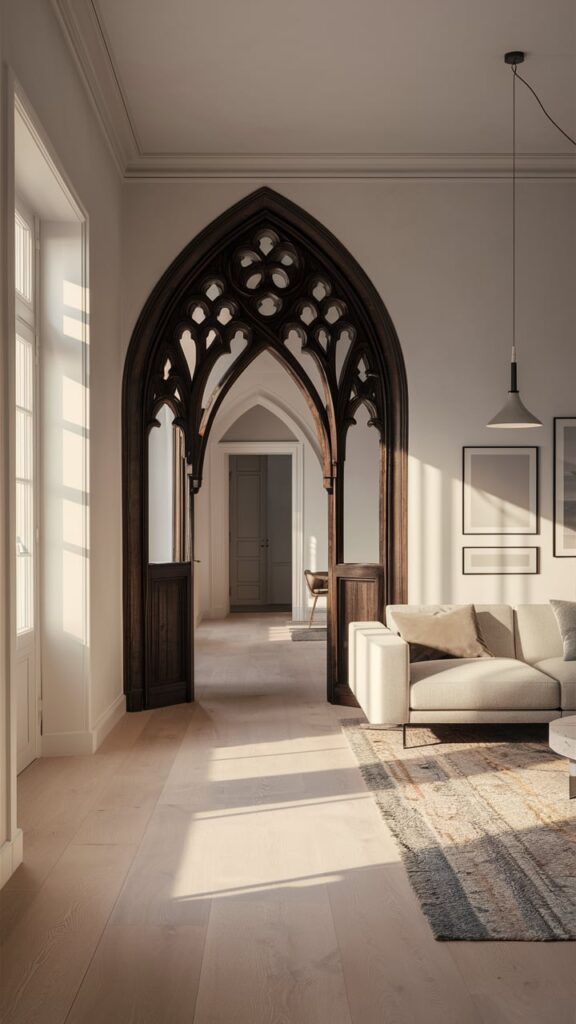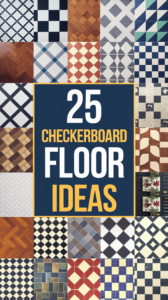Transform your living spaces with the timeless elegance of archways. Whether you use them to frame a doorway or create a focal point, archways add architectural interest and charm to any home. They provide a seamless transition between rooms while enhancing the overall aesthetic appeal.
From simple, minimalist designs to more elaborate, decorated arches, there are countless ways to incorporate this classic element into modern interiors. Discover how archways can elevate your home decor with versatile and stylish options that suit any taste.
1. Gothic Revival Archways
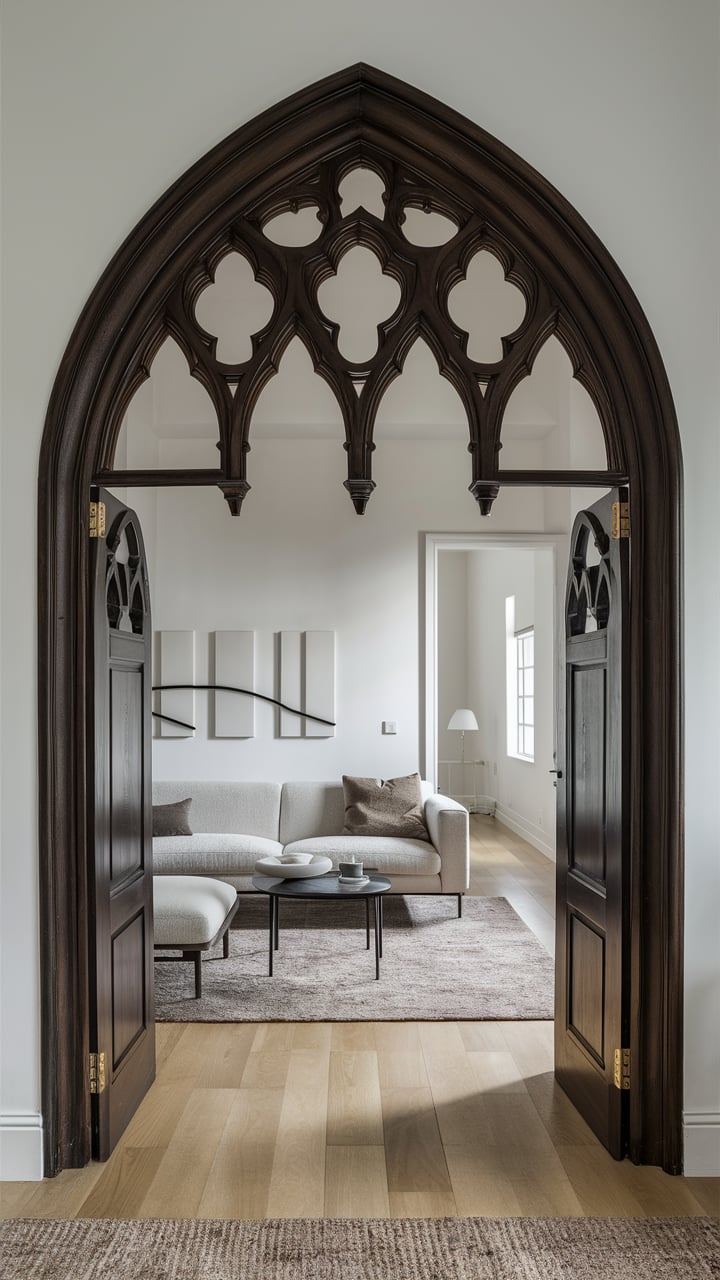
Gothic Revival archways bring a sense of grandeur and historical charm to any home. Inspired by medieval design, these archways are characterized by their pointed arches, intricate tracery, and detailed carvings.
You can integrate these archways into a modern home to add a dramatic effect without overwhelming the space. They can be used to frame doorways, windows, or even hallways, providing both functional and aesthetic enhancements.
A Gothic Revival archway often features dark wood or stone, creating a striking contrast with lighter interiors. This style is perfect for those looking to incorporate classic architectural elements with a touch of elegance.
2. Mediterranean-Style Arches

Mediterranean-style arches bring a distinct elegance and warmth to home interiors. Characterized by their smooth curves and generous proportions, these arches often create a welcoming ambiance.
Popular in Mediterranean architecture, these archways pair beautifully with stucco walls and terracotta flooring. French Provincial styles also often feature arched mirrors and antique armoires with arched tops.
Integrating Mediterranean arches can enhance both indoor and outdoor spaces, contributing to a harmonious and classic aesthetic.
3. Modern Minimalist Arches

Modern minimalist arches embody simplicity and elegance. These arches focus on clean lines and understated forms, often appearing as sleek curves that seamlessly blend into the architecture.
They are typically crafted from materials like concrete, steel, or wood, enhancing their minimalistic appeal. Subtle yet impactful, these arches can transform spaces by adding a contemporary touch without overwhelming the design.
Their lack of ornamentation makes them versatile, fitting effortlessly into various home styles. In open-plan spaces, minimalist arches help define areas without the need for walls, maintaining an airy and expansive feel. These arches emphasize functionality while contributing to the visual flow of the home.
4. Rustic Wooden Beams
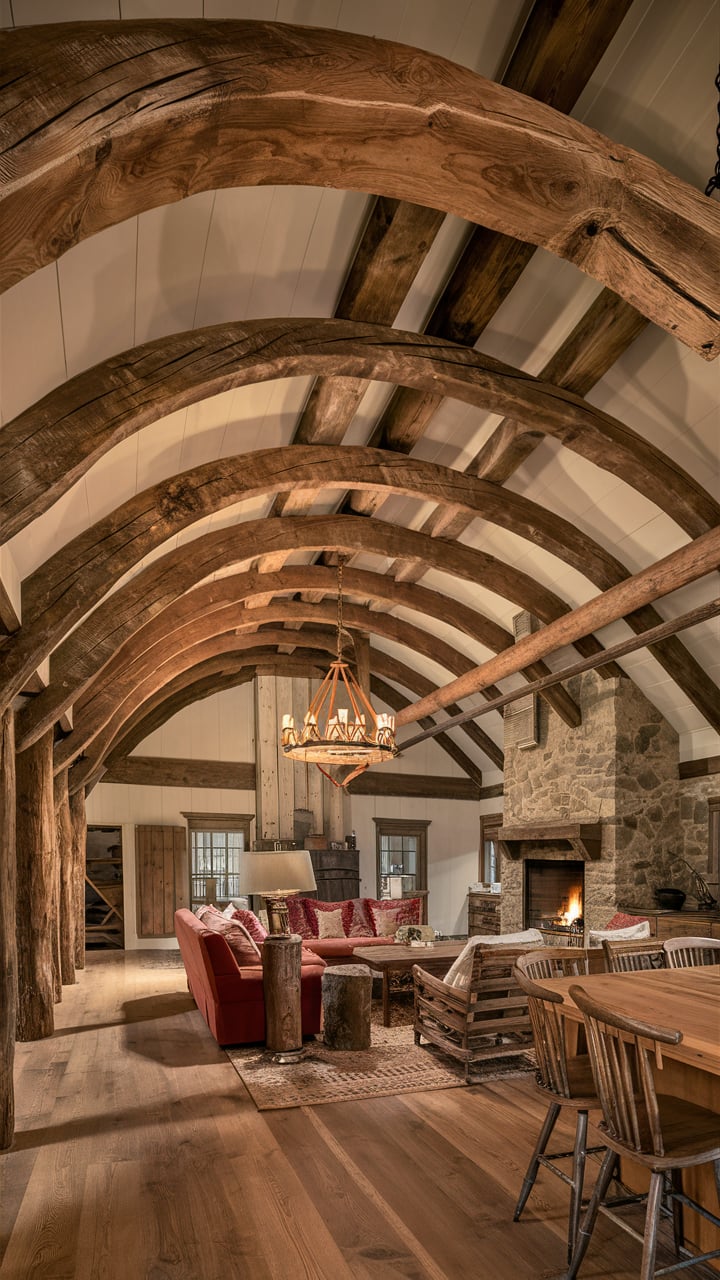
Rustic wooden beams lend a natural, earthy charm to home interiors. These beams, often left in their raw state, deliver a warm and inviting atmosphere. They are particularly effective in spaces aiming for a country or farmhouse look.
A popular method involves installing these beams across ceilings or over doorways. This creates a striking visual centerpiece. The beams can be weathered or stained to match specific design tastes, enhancing the rustic appeal of the home.
Integrating accessories such as wooden plaques or vintage signs can complement the beams. These additions further emphasize the rustic aesthetic, giving the space a cohesive and charming character.
5. Stone Masonry Arches
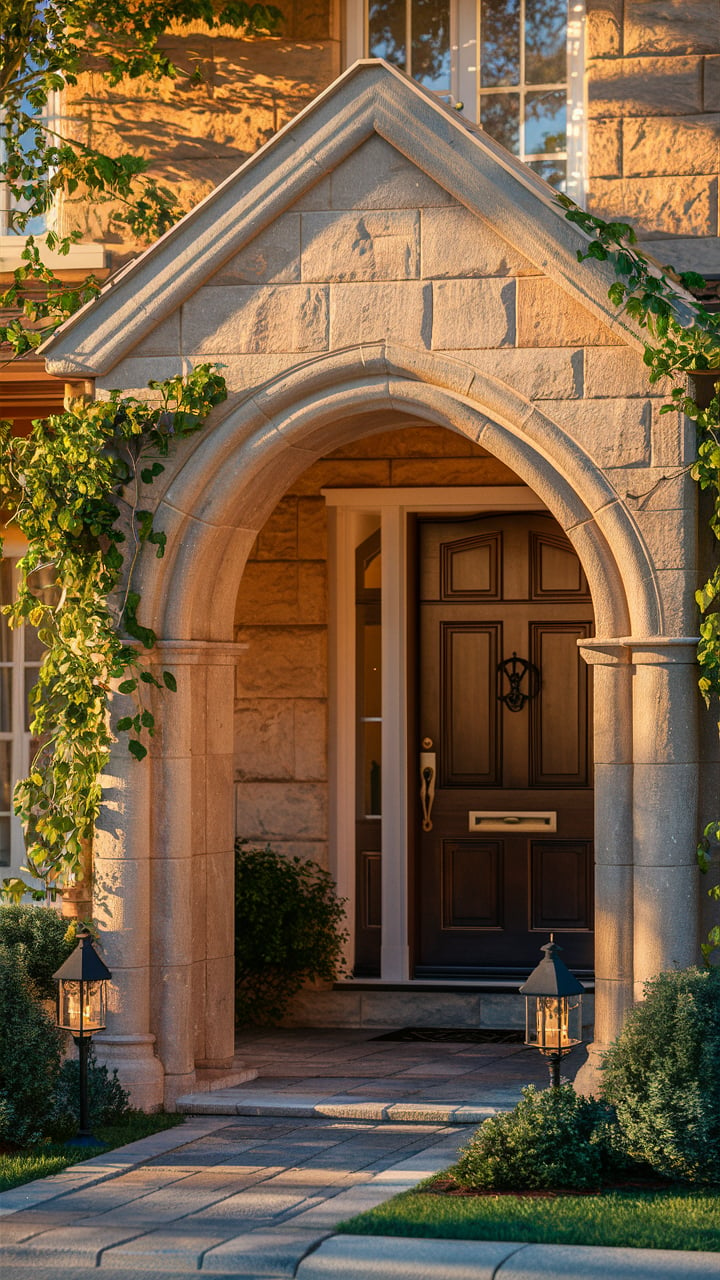
Stone masonry arches stand as timeless architectural elements, adding both strength and beauty to any home. You can employ them in various styles, such as traditional or rustic.
These arches often feature in entryways, creating a grand and welcoming atmosphere. Inside the home, they anchor spaces, designating transitions between rooms with elegance.
Choosing the right stone is crucial. Natural stones like granite, limestone, and sandstone offer durability and distinct aesthetics. Their textures and colors bring a rich, organic feel to the structure.
Incorporating stone masonry arches requires skilled craftsmanship. Proper construction ensures the arch remains stable while serving as a focal point. These features, when done correctly, can significantly enhance the architectural appeal of a home.
6. Indoor Garden Archways
Indoor garden archways bring a touch of nature indoors, creating a serene atmosphere. These archways can be adorned with climbing plants like ivy or jasmine, which thrive in indoor environments.
Using wooden or metal frames gives the archway a sturdy structure, allowing the plants to grow and cascade beautifully.
Incorporating see-through curtains can enhance the aesthetic appeal and allow light to filter through, making the space appear airy and bright. Beaded curtains can also be used for a decorative touch, providing both privacy and a natural element.
7. Victorian-Style Arches

Victorian-style arches bring an element of grandeur and intricate detail to any home. Characterized by their ornate designs, these arches often feature elaborate moldings and carvings.
These arches can be incorporated into various spaces, from entryways to living rooms, adding a sense of historical elegance. Often found in older homes, Victorian arches can also be integrated into modern interiors for a unique blend of old and new.
Using Victorian-style arches, homeowners can achieve a timeless and sophisticated look.
8. Industrial-Style Archways

Industrial-style archways often feature raw materials like exposed brick, steel, and concrete. These elements bring a modern, edgy vibe to the home.
Metal framing around the archway can enhance its industrial appeal. Using dark, matte finishes can add to the effect.
Mixing in some rustic elements, such as reclaimed wood, can soften the look, creating a balanced aesthetic.
9. Art Deco Arches
Art Deco arches bring a touch of 1920s glamour to any home. Characterized by simple shapes and geometric decorations, these arches often incorporate metallics and jewel tones. Think jade, silver, and chrome.
They often feature arched doors and windows, adding elegance to both interiors and exteriors. The rich color schemes and stylish details make Art Deco arches a striking addition to any space.
10. Tuscan Arch Designs

Tuscan arch designs are characterized by their use of natural materials such as wood and stone. These elements bring a sense of rustic elegance to the home, often highlighted with wrought iron accents.
The arches are typically wide and sturdy, reflecting the architectural heritage of Tuscany. Incorporating these arches in entryways, windows, and hallways can create a seamless flow throughout the home.
Color palettes often feature warm, earthy tones, enhancing the overall Mediterranean aesthetic. Red terracotta tiles and aged finishes further accentuate the Tuscan charm. Integrating these design elements can transform modern spaces into timeless settings.
11. French Country Archways

French Country style embraces old-world charm and rustic features. The archways often showcase natural materials like stone or wood, adding to the timeless appeal.
These archways can be both functional and decorative. They create a smooth transition between interior rooms or from the house to outdoor spaces.
Details such as intricate carvings or distressed finishes further enhance the elegant yet cozy atmosphere of a French Country home. Arched doorways and windows, with their soft curves, contribute significantly to the home’s inviting and warm aesthetic.
12. Traditional Brick Archways

Traditional brick archways bring timeless elegance to any home. These archways often feature classic designs that evoke a sense of history and charm. The use of brick adds both durability and aesthetic appeal.
They work well in various spaces, including living rooms, entryways, and hallways. Their versatility makes them a popular choice for homeowners aiming to blend traditional elements with modern living.
The craftsmanship involved in creating traditional brick archways is noteworthy. Each brick’s placement requires precision to achieve the desired curvature and strength. This attention to detail ensures the archway’s longevity and adds a distinctive architectural feature to the home.
13. Bohemian Arch Ideas

Bohemian archways create an eclectic and vibrant atmosphere in a home. They can be adorned with colorful textiles, like hanging tapestries or macrame, which add a boho-chic flair.
Incorporating plants around the archway enhances the natural and relaxed vibe, and selecting vintage or distressed furniture can complement the look beautifully.
Using soft, warm lighting sources such as lanterns or fairy lights can bring a dreamy, inviting feel to the space, perfectly embodying the bohemian spirit.
14. Arched Alcove Shelves
Arched alcove shelves bring a touch of elegance and architectural beauty to any living space. They blend seamlessly with various interior styles, from traditional to modern.
These shelves are perfect for displaying decorative items, books, or art. Their curved design adds depth and interest to otherwise flat walls.
Utilizing the natural alcoves often found beside fireplaces or in hallways, arched shelves can enhance both functionality and aesthetics. They offer a unique way to showcase personal belongings while adding a stylish architectural feature to the room.
15. Spanish Colonial Arches

Spanish Colonial arches are a defining feature of Spanish-style architecture. These archways often feature soft, rounded curves that lend a natural elegance to the structure.
Often constructed with white or off-white stucco, they complement the red barrel tile roofs typically found in Spanish Colonial homes. The arches can be found in interior spaces like hallways and doorways, as well as exterior spaces such as courtyards and entrances.
These architectural elements are sometimes adorned with dark carved wood, enhancing their rustic appeal. The combination of materials and design elements creates a warm, inviting atmosphere that is characteristic of Spanish Colonial style homes.
16. Open Concept Room Dividers
Open concept room dividers offer a stylish way to section off spaces without compromising the openness. They can be as simple as sliding panels or as intricate as built-in shelving units.
These dividers can enhance privacy and create designated zones for different activities, making a home more functional. Artistic options like hanging curtains or large plants can add aesthetic value.
Using materials like wood, glass, or metal, room dividers can complement various interior styles. They help in maintaining a sense of flow while carving out cozy nooks for work, relaxation, or dining.
17. Historic Renaissance Arches

Historic Renaissance arches are iconic elements of Renaissance Revival architecture. These arches often feature rounded forms and elegant proportions, drawing inspiration from classical Roman design.
Such arches can be seen in buildings like Hamburg City Hall in Germany, constructed between 1886 and 1897. They showcase detailed craftsmanship and create a sense of grandeur within the architectural space.
Renaissance arches not only serve structural purposes but also add aesthetic value. Their design often includes decorative elements such as intricate moldings and keystones, reflecting the artistry of the Renaissance period.
18. Arched Vanity Mirrors

Arched vanity mirrors bring a unique blend of elegance and functionality to the bathroom. These mirrors can transform an ordinary space into a sophisticated retreat. They are perfect for those looking to enhance their vanity areas.
Design options vary, from sleek frameless designs to those with ornate frames. Each style adds its own charm and character to the bathroom. Practical and visually appealing, arched mirrors are a popular choice for contemporary and traditional homes alike.
They not only serve a functional purpose but also act as decorative elements. The smooth, curved lines of arched vanity mirrors soften the overall look of a bathroom, making it feel more inviting and comfortable.
19. Barrel Vaulted Ceilings
Barrel vaulted ceilings create an elegant and timeless look that adds architectural interest to any space. This unique style features an arch that extends from one wall to the other, creating a smooth, curved surface above.
Commonly found in living rooms, kitchens, and hallways, these ceilings can incorporate custom round steel frames and recessed lighting for added effect. Historical examples of barrel vaulting date back to ancient Rome and Persia, showcasing its enduring appeal.
Today, barrel vaulted ceilings can be adapted to various modern interiors, blending with both traditional and contemporary designs. They not only enhance the aesthetic appeal but also contribute to a spacious and airy atmosphere in the home.
20. Contemporary Steel Arches

Contemporary steel arches bring a modern, industrial flair to home interiors. Their sleek lines and sturdy construction offer a distinct contrast against softer materials like wood or fabric.
These steel arches are versatile, seamlessly blending into both minimalistic and more elaborate designs. They can frame entryways, create defined spaces, or even act as bold architectural statements.
The use of steel ensures longevity and low maintenance while maintaining a chic, modern aesthetic. They can be left in their natural metallic finish or painted to match the surrounding decor.
Ancient Architectural Influences
Archways originated from the ingenuity of ancient civilizations. The earliest known uses date back to the Persians and Mesopotamians, but it was the Romans who truly innovated with arches. Roman arches, characterized by their semicircular shape, allowed for the construction of more durable and expansive structures.
In medieval Europe, Gothic arches emerged, distinguished by their pointed design. These arches were not only structurally significant but also added an element of verticality and grandeur to cathedrals and castles. They often illustrated high craftsmanship and the technological prowess of the era, serving both aesthetic and practical purposes in architecture.
Modern Adaptations
In contemporary home design, archways have evolved to blend classical charm with modern aesthetics. Today’s designers experiment with diverse shapes, such as elliptical and Tudor arches, to create unique interior focal points. These modern archways are often used to delineate spaces within open floor plans, adding character without compromising flow.
Modern homes might feature large arched windows or doorways, providing both visual appeal and increased natural light. Additionally, creative uses of materials like metal, glass, and wood enhance the versatility of archways, making them adaptable to various design themes whether minimalist, rustic, or industrial. This adaptability highlights the enduring appeal and functional benefits of archways in home design.
Types of Archways for Homes
Archways can greatly enhance the architectural beauty and visual interest of a home. Different styles such as Roman, Gothic, and Tudor arches each bring unique characteristics and historical significance to interior and exterior spaces.
Roman Arches
Roman arches are characterized by their rounded, semicircular shape. This design distributes weight efficiently, allowing the construction of large and stable structures. Roman arches are often found in grand entryways and hallways, giving an elegant and timeless look to a home. These arches can be created using materials like stone, brick, or wood, each providing a distinct aesthetic.
In modern homes, Roman arches offer classic appeal and can be integrated into various spaces, such as between the living and dining areas. They can also be embellished with moldings or keystones to add a touch of sophistication. Roman arches not only highlight architectural detailing but also help to visually enlarge the space by drawing the eye upwards.
Gothic Arches
Gothic arches are easily recognizable by their pointed apex. This vertical emphasis creates an impression of height and grandeur, making them a popular choice in ecclesiastical and historical buildings. In residential settings, Gothic arches add a dramatic flair and can be used in doorways, windows, or ceiling vaults.
Typically constructed from stone or wood, Gothic arches can be either simple or intricately detailed with tracery and carvings. They are ideal for homes aiming to incorporate a medieval or classical European aesthetic. The pointed design is not just for decoration; it also channels weight downwards, making it a structurally sound option for larger openings or vaulted ceilings.
Tudor Arches
Tudor arches are distinguished by their shallow, flattened shape that is slightly pointed at the top. This style originated during the Tudor period in England and is often seen in residential architecture for its subtle elegance. Tudor arches are suitable for creating intimate passageways and are often used in smaller openings compared to Roman or Gothic arches.
These arches work well with brick and stone construction, imparting a charming and cozy atmosphere. In homes, Tudor arches can be used in fireplaces, doorways, and windows to add historical character. They blend seamlessly with other traditional architectural elements like timber-framed walls, making them versatile for various design themes.
Materials for Archway Construction
Various materials are used in the construction of archways, each offering distinct aesthetics and structural benefits. Common options include wood, stone, and metal, each bringing unique characteristics to an interior space.
Wood
Wood is a versatile material for archways, providing warmth and natural charm. It can be carved into intricate designs or left plain to highlight its grain. Popular wood types include oak, cherry, and pine due to their durability and ease of shaping.
Wood requires proper treatment to protect against pests and moisture. Finishing options like staining or painting can enhance its appearance and longevity. It is widely used in both modern and traditional design schemes, making it a favored choice for many homeowners.
Installation involves attaching wooden frames directly to walls, often reinforced with additional supports. This method is relatively straightforward, especially for DIY enthusiasts, and allows for creative customization. With proper care, wooden archways can remain a lasting feature in any home.
Stone
Stone archways exude a timeless and sturdy appeal. Materials such as granite, limestone, and sandstone are commonly used. These stones provide a solid, rustic, and elegant look that is hard to replicate with other materials. Each type of stone brings its distinct color and texture, adding character to the design.
Constructing a stone archway can be labor-intensive and typically requires skilled masonry. The process involves cutting and arranging stones, using mortar to secure them in place. Due to its weight, a strong foundation and support are essential to prevent structural issues.
Stone archways are highly durable and can withstand various environmental conditions. Their natural beauty and strength make them ideal for creating focal points in both interior and exterior spaces. Regular maintenance ensures they remain an impressive feature for decades.
Metal
Metal archways offer a modern and industrial aesthetic that suits contemporary interiors. Common metals include steel, iron, and aluminum. These materials are known for their strength and sleek appearance, making them ideal for creating striking architectural features.
Metalwork can be intricate, with options for welding and bending into elaborate designs. Metal archways are often powder-coated or painted to prevent rust and enhance their visual appeal. They can be installed as standalone structures or integrated into walls for added stability.
Installation of metal archways typically requires professional expertise due to the precision and tools involved. Despite the higher cost and complexity, metal archways offer lasting durability and minimal maintenance. They provide a bold, modern look that can significantly enhance the design of any home.
Frequently Asked Questions
Archways can transform any space with their unique design elements, offering styles from rustic wooden beams to minimalist modern arches. Here are answers to some frequently asked questions about archways in homes.
What are some creative ideas for decorating arches in a living room?
Decorative options for living room archways abound. A weathered wooden plaque can introduce a rustic charm. Painting or wallpapering the archway adds a splash of personality and color. Hanging plants or fairy lights can also enhance the visual appeal of the space.
How can I DIY an archway in my home?
Creating a DIY archway involves preparation and creativity. Prepare the space by sanding and priming the surface. Painting or applying faux finishes like brick or wood texture can achieve the desired look. Tools like stencils can help introduce intricate patterns.
What are the current trends for including arches in home design?
Current trends incorporate arches in various styles such as Gothic Revival, Mediterranean, and Modern Minimalist. Each style brings a distinct flair. For instance, Mediterranean-style arches often feature ornate details, whereas modern minimalist arches focus on clean lines and simplicity.
What are some exterior arch designs for houses?
Exterior arch designs may include stone masonry, which offers a timeless and sturdy appearance. Metal or wooden pergolas can provide a crafted look. Mixed-material arches using brick and wood elements can create an inviting and charming entrance.
How can I effectively incorporate an archway into my home’s outdoor space?
Outdoor archways enhance garden paths or patios. Use climbing plants like vines or roses to adorn the archway. Incorporating lighting within the archway can illuminate the space during evenings. Opt for materials that withstand weather, such as treated wood or metal.
What are the design considerations for adding a square archway in a house?
Square archways should match the home’s architecture. Ensure that the proportions are balanced with the surrounding elements. It’s crucial to select materials that complement the interior decor. Use molding or trim to define the shape and add visual interest.
